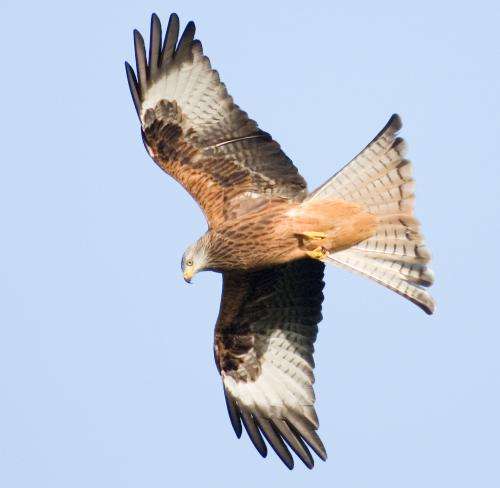Study reveals north/south genetic divide in Welsh red kite

A study of the modern red kite population in Wales has revealed a north/south genetic divide that runs along the Towy Valley.
This is one of the findings of a study of the genetic status of the red kite in Wales by Aberystwyth University postgraduate student Ilze Skujina.
The research was undertaken as part of a project to provide guidance on the long-term conservation of the red kite.
Originally from Latvia, Ilze Skujina is no stranger to Aberystwyth having studied her undergraduate degree here in Equine Science and is now studying for a PhD at the Institute of Biological, Environmental and Rural Sciences (IBERS).
The red kite is a medium sized bird of prey with a reddish-brown body, angled wings and a forked tail.
At the turn of the 20th century, they were extinct in England and Scotland with just a handful of breeding pairs surviving in Wales.
The lowest point was in the 1930s when only a single nest was known in Wales.
From the late 1960s the Welsh population increased slowly and reached around 100 pairs by 1990.
As a result of the relatively slow rate of expansion and recolonization of old habitats, supporters initiated a centralised red kite re-introduction program across the rest of the UK using some birds from Wales but mainly birds from other European populations.
This has been one of the most successful reintroduction programs of any species and red kites are now a common site across England and Scotland with an estimated 1,800 breeding pairs in the UK.
Ilze said; "I accompanied Professor Mike Hayward of the Welsh Kite Trust and Tony Cross of Ecology Matters and Consultant Ornithologist to the Welsh Kite Trust, on their nest monitoring and chick tagging visits across the traditional core areas of the species in Wales and the contact areas between the expanding Welsh and English populations in Shropshire and Herefordshire and gathered cast feather samples and extracted DNA from the feathers.
"This proved to be an efficient and most importantly, non-invasive way of collecting DNA. The molecule acts like a bar-code and provides geneticists with information about the relations between populations and individuals.
"Using the cutting edge facilities in the Translational Genomics laboratory at IBERS and novel genetic markers developed in our lab, I was not only able to reconfirm that the modern Welsh kite population still fall into a Northern and Southern groups (as had been detected in the 1980s using the single genetic fingerprint probe available at the time) but also detect a genetic difference between the older Central-Welsh and the relatively new red kite population in Shropshire and Herefordshire."
Robert McMahon, Research Associate at IBERS Phenomics Centre overseeing Ilze's research work explains, "Field studies of ringed birds in the 1970s had suggested that the Kites tended to nest close to where they had hatched, but this is the first indication of the genetic significance of this behaviour in what otherwise looks like a single population undergoing expansion from 100-1000 breeding pairs over the intervening years.
"Despite being capable of daily flights of over 100km and a significant expansion in numbers and geographical range, the Northern and Southern birds are choosing to nest close to where they were born, maintaining a partially stable genetic barrier over 30 breeding seasons.
"The research also detected evidence that the re-introduced kites have started to mate with Welsh birds."
Tony Cross of the Welsh Kite Trust adds; "We knew from tag sightings that at least some of the pioneering kites that first bred in West England, in Herefordshire and Shropshire, were descendants of the original British stock but we also knew, despite a lack of evidence from marked birds, that there was highly likely to have been some ingress from the re-introduced birds derived from Spanish and German populations. It is great to have genetic "proof" of this through Ilze's work and it will be interesting to investigate if productivity and habitat selection are influenced by genetic origin."
As part of her PhD research, Ilze is studying avian genomes and their link to longevity which came about as a result of her red kite project.
Ilze added; "I was awarded an Owen Price Scholarship to study my PhD. Not only has it enabled me to pursue my chosen career pathway, but it has the potential to influence the global science community by increasing general understanding of ageing."
Ilze's MPhil was funded by Knowledge Economy Skills Scholarships (KESS) under the European Social Fund Convergence Programme by the Welsh European Funding Office (WEFO), in partnership with Ecology Matters based in Talybont and in collaboration with the Welsh Kite Trust based in Llandrindod Wells.
Provided by Aberystwyth University




















